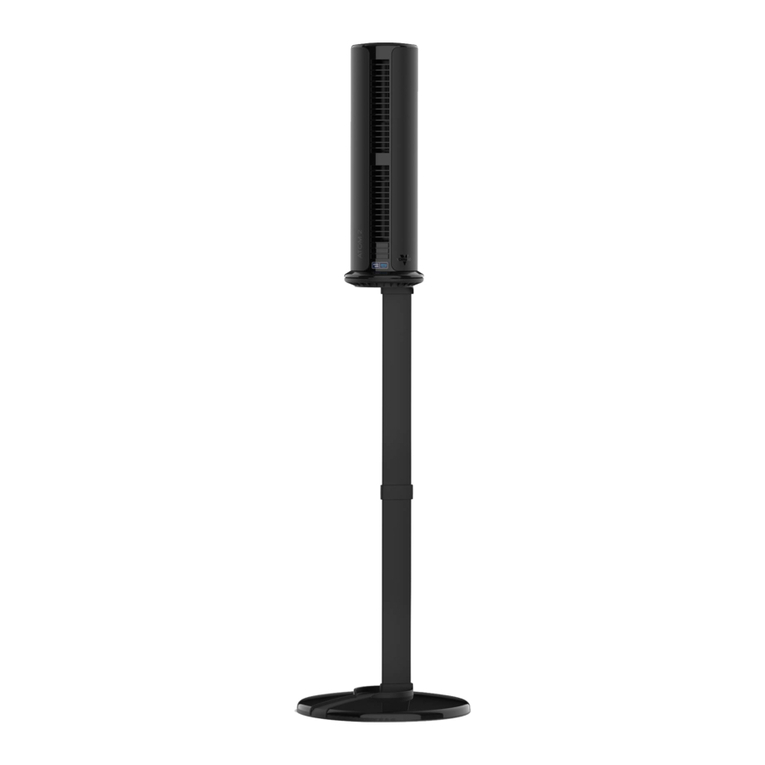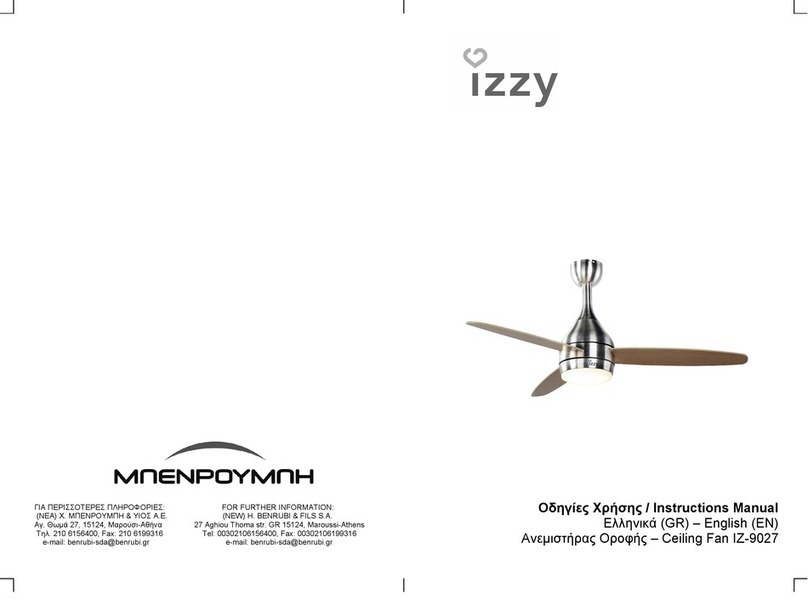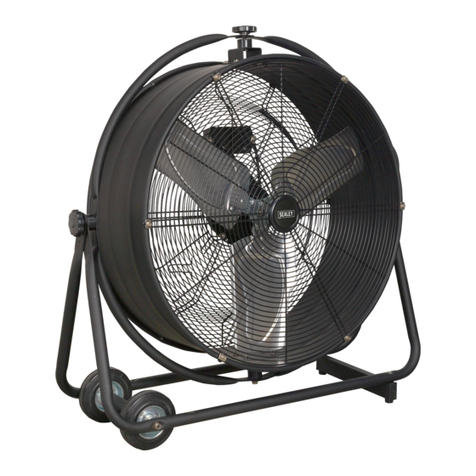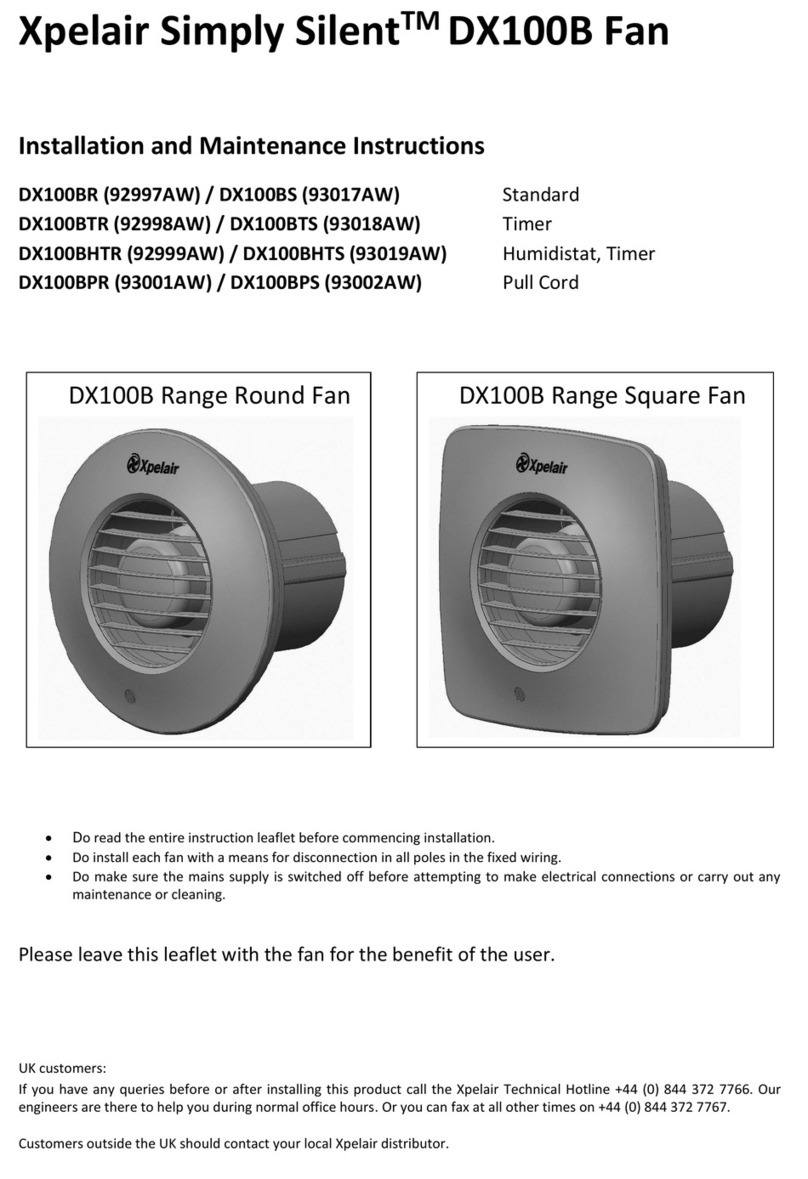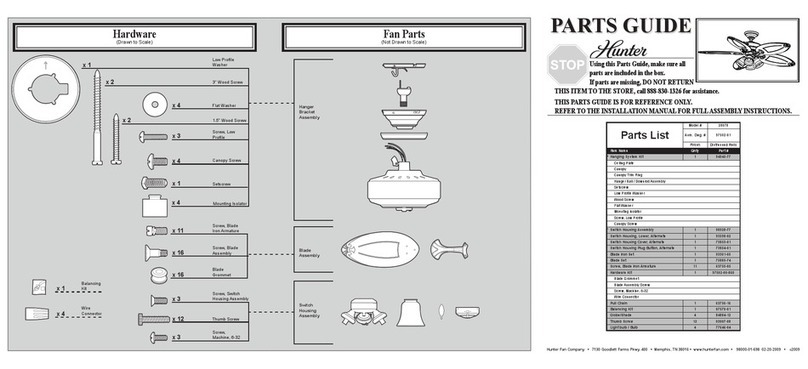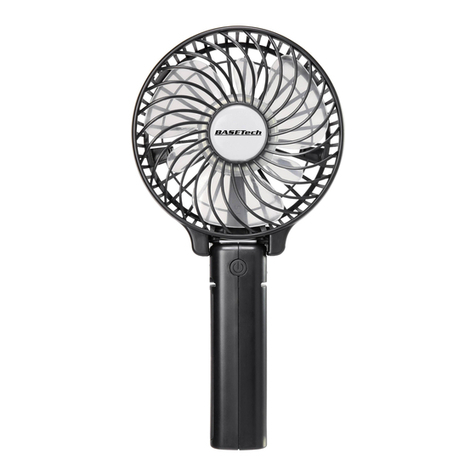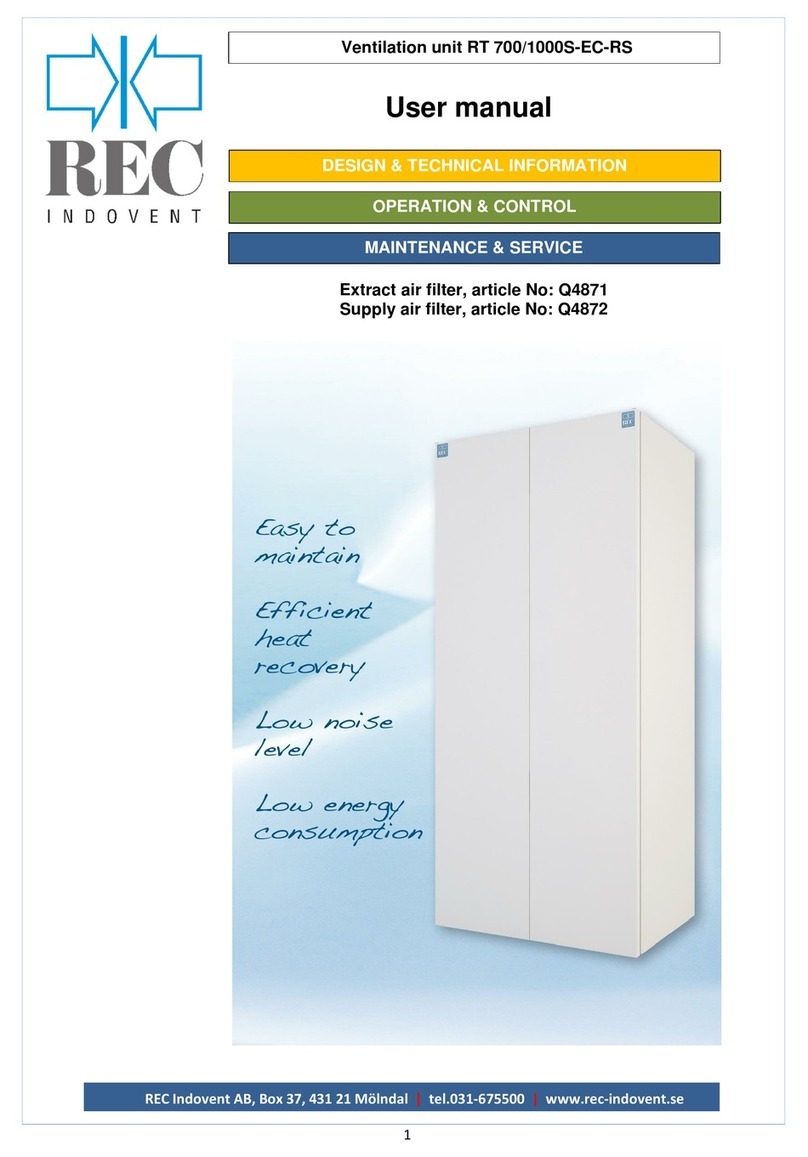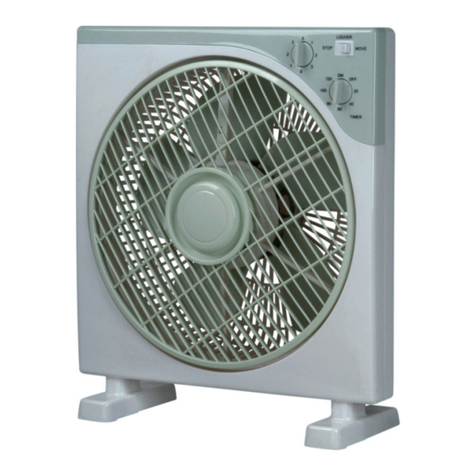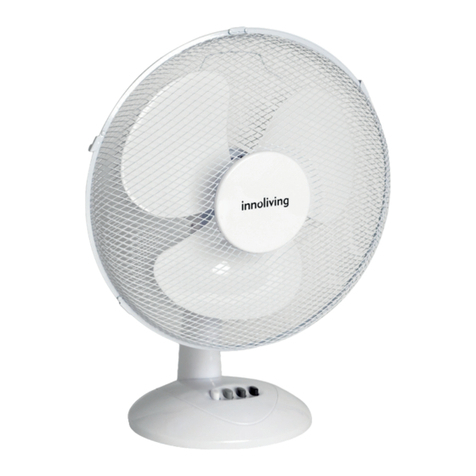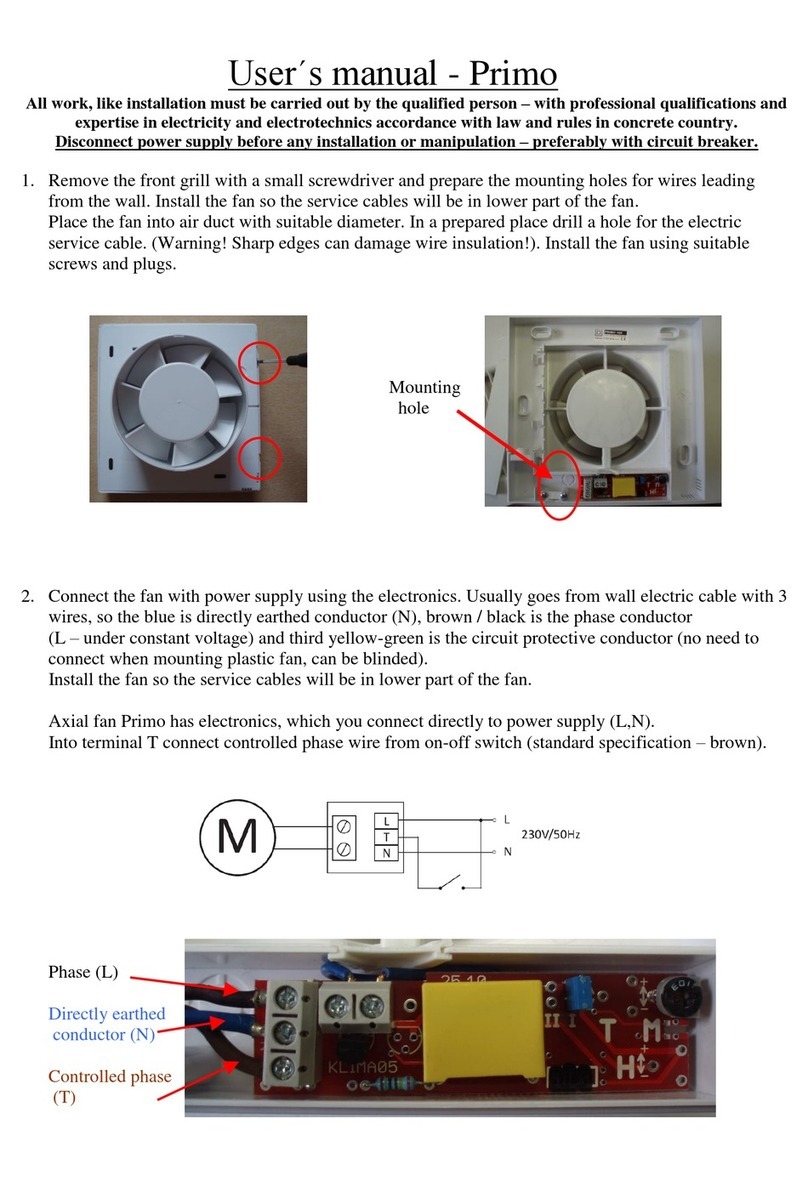Spring Air Systems HT-B User manual

VENTILATOR
MAINTENANCE MANUAL
___________________________
Spring Air Systems Inc., Oakville, Ontario
Phone (905) 338-2999, Fax (905) 338-0179

Ventilator Operating and Maintenance
Manual
Table of Contents
Introduction 1
Model Numbers 2
Water Wash Control Panels 2
Control Panel Operation 3
Single Sequence Wash 3
Two Sequence Wash 4
Three Sequence Wash 5
Four and Five Sequence Wash 6
Remote Piping 7
Cleaning the Exterior 7
Wash Timer Settings 7
Automatic Wash Systems 8
Setting the Automatic Time Clock 9
Grease Extractor Operation: Type “C” 14
Grease Extractor Operation: Type “H” 14
Grease Extractor Operation: Type “D” 15
Ventilator Wash System 15
Hot and Cold Water Requirements 18
Second Line Fire Suppression: Arrangement “D” 20
Second Line Fire Suppression: Arrangement “T” 21
Second Line Fire Suppression: Arrangement “F” 22
Variflow Baffles 23
SB10H One Sequence Wash Plumbing Schematic 24
SBA10C One Sequence Wash Plumbing Schematic 25
MP20C Two Sequence Wash Electrical Schematic 25
MP20H Two Sequence Wash Electrical Schematic 25
AP30C Three Sequence Wash Electrical Schematic 26
MP30H Three Sequence Wash Electrical Schematic 26
SBA10C/SBA10H One Sequence Wash with time clock electrical 27
AP10C/AP10H One Sequence Wash with time clock electrical 27
AP20C/AP20H Two Sequence Wash with time clock electrical 28
AP30C/AP30H Three Sequence Wash with time clock electrical 28
Maintenance Schedule 29
Measuring the Exhaust Airflow 30
Start Up Procedure 31
Trouble Shooting 31
Start Up Report 33
Detergent Pump Parts List 35

_____________________________________________________________________________________________
Spring Air Systems Water Wash Ventilator Maintenance Manual 11/01 1
VENTILATOR
OPERATING AND MAINTENANCE MANUAL
INTRODUCTION
Thank you for selecting a SPRING AIR SYSTEMS INC. commercial exhaust water wash grease extractor. Your system
consists of a water wash ventilator hood, a water wash control panel and plumbing box, an exhaust fan and make air unit.
Others may have supplied the exhaust fan and make up air unit.
SPRING AIR commercial kitchen ventilators have been designed and constructed in accordance with the National
Building Code, the National Fire Protection Association (NFPA-96), and listed by Underwriters Laboratories of Canada
and Underwriters Laboratories Inc. In addition the SPRING AIR SYSTEMS ventilator will meet all municipal code
requirements.
Each SPRING AIR ventilator is individually constructed to suit the space limitations of your commercial kitchen. The
SPRING AIR ventilators are fabricated from No. 4 finish stainless steel with all the edges ground and polished. All
ventilators are manufactured to stringent quality standards and are guaranteed to enhance the appearance of any
commercial kitchen.
Model HT-B Water wash Ventilator and model MP10H-19 Control Panel
Figure 1
The exhaust fan operation is controlled by a selector switch on the control panel or automatically by an electronic
microprocessor based, 24-hour timer. Each time the exhaust fan is turned off the internal grease extractor portion of the
ventilator hood is washed with a detergent and hot water mixture.
The SPRING AIR water wash grease extractor was designed to best meet the needs of your commercial kitchen. The
SPRING AIR ventilator (hood) provides the following important benefits:
1. Maximum Grease Extraction.
2. Automatic Daily Wash.
3. Second Line Fire Protection.
4. Minimum Exhaust Requirements.
Please read the manual carefully to familiarize yourself with your water wash ventilator. A factory trained service
technician will complete a startup of your system. A copy of the start up report is available upon request.
Each ventilator and control panel is described in detail. Refer to the UL/ ULC plate on your ventilator and water wash
control panel for your model numbers before proceeding.

_____________________________________________________________________________________________
Spring Air Systems Water Wash Ventilator Maintenance Manual 11/01 2
MODEL NUMBER DESIGNATIONS - VENTILATORS
A well-designed commercial kitchen ventilation system must consider proper ventilation, superior grease collection, and
daily cleaning and second line fire protection.
There exist numerous types, styles and arrangements of SPRING AIR SYSTEMS ventilators that meet these design
requirements. Refer to the ULC label for the complete model number of your ventilator. The ULC label is located on the
underside of the grease trough on the right hand side of the ventilator.
SPRING AIR SYSTEMS HOOD MODEL NUMBER DESIGNATIONS
H T B MP 10 4
C Cold water spray/hot water wash
H Hot water wash
D Dry Grease Extractor
T Thermostatic Fire Damper
F Fusible link, spring loaded fire damper
D Fusible link, dead weight fire damper
S Shelf type hood
B Box type hood
BS Box shelf type hood
DB Double box type hood
MG Make up air through front grilles
MP Make up air through perforated panels
MI Make up air internally
F Single row canopy finished on all sides, Rev-
Low type
10 The length of the ventilator in feet
4 The width of the ventilator in feet
Model Number Designation - Ventilators
Chart No1
MODEL NUMBER DESIGNATIONS - CONTROL PANELS
A P 10 C 19
A Automatic stop/start with time clock
M Manual stop/start
S Single sequence small panel
P Large size plumbing box
B Small size plumbing box
BA Small size plumbing box with time clock
10 One sequence
20 Two sequence
30 Three sequence
40 Four sequence
50 Five sequence
C Cold water spray/hot water wash
H Hot water wash
19 Diameter of inlet to panel in mm
Model Number Designation - Control Panels
Chart No.2

_____________________________________________________________________________________________
Spring Air Systems Water Wash Ventilator Maintenance Manual 11/01 3
An integral part of any SPRING AIR SYSTEMS water wash ventilator is the water wash control panel. The water wash
control panel controls the exhaust fan operation the daily wash and second line fire protection system.
CONTROL PANEL OPERATION
Sequence of Operation: All panels
Exhaust fan: To start the exhaust fan rotate the fan selector switch to the “ON” position. The green “FAN ON” pilot and
exhaust fan will turn on. The exhaust fan starter coil is energized through terminals 3 and 4 in the water wash control
panel.
Supply fan: Power is provided for a fresh air motorized shut off
damper through terminals 4, 8, & 9. The damper motor is energized
through terminals 4, & 8. Once an end switch closes 120V/1/60
power is supplied back to the control panel through terminal 9. The
supply fan motor starter is then energized through terminals 4 & 9.
When a motorized damper with end switch is not used in the
installation the field electrician must jumper terminals 8 & 9 in the
water wash panel to provide 120V/1/60 power to the supply fan motor
starter.
MP10C & MP10H Wash Panel
Figure 2
Cold Water Spray Panels (SB10C/MPx0C/APx0C)
When the fan selector switch is rotated to the “ON” position the cold water spray solenoid valve is energized. The cold-
water spray operates while the exhaust fan is operating. The cold-water spray can be observed by looking into the inlet
slot of the grease extractor. All nozzles should be spraying to form a uniformed water pattern along the length of the
ventilator.
To stop the exhaust and supply fan rotate the selector switch to the “OFF” position. The green fan “ON” pilot and the
exhaust fan will turn off.
Cold Water Spray Panels (SB10C/MPx0C/APx0C).
In addition the cold-water spray solenoid valve will close.
SINGLE SEQUENCE WASH
MODEL: SB10C, SB10H
CAPACITY:
One ¾” (19 mm) to 1.25” (32 mm) hot water inlet and one ¾” (19 mm) to 1.25” (32 mm) hot water outlet connections for
washing p to 46 ft. (14 m) of ventilator.
Model SB10C and SB10H control panel internal wiring
Figure 3

_____________________________________________________________________________________________
Spring Air Systems Water Wash Ventilator Maintenance Manual 11/01 4
MODELS: MP10C, MP10H
CAPACITY:
One ¾” (19 mm) to 1.5” (38 mm) hot water inlet and one ¾” (19 mm) to 1.5” (38 mm) hot water outlet connections for
washing up to 50 ft. (15 m) of ventilator.
When the selector switch has been rotated to the “OFF” position, after a 60 second time delay, the blue “WASH” pilot the
detergent pump and hot water solenoid valve are energized. The hot water and detergent mixture flow to the ventilator
and enter the grease extractor through an inlet pipe connected to the spray manifold. The detergent water mixture is
sprayed from nozzles spaced uniformly along the length of the wash manifold washing the grease dirt and lint from the
grease extractor baffle and into the drain.
The wash continues for the period of time set on the wash timer adjustable from 0 to 600 seconds. At the end of the
wash cycle the blue “WASH” pilot, the detergent pump and the hot water solenoid valve shut off. The system remains
idle until the next time the fan selector switch is turned to the “ON” position.
Single Sequence Wash MP10C & MP10H Electrical Wiring
Figure 4
TWO SEQUENCE WASH
MODELS: MP20C, MP20H
CAPACITY: One ¾” (19 mm to 1.5” (38 mm) hot water inlet and two ¾” (19 mm) to 1.5” (38 mm) hot water outlet
connections for washing up to 100 ft. (30 m) of ventilator.
When the fan selector switch has been rotated to
the “OFF” position, after a 60 second delay, the
blue “WASH #1” pilot, the detergent pump, and the
hot water solenoid #1 are energized.
The detergent and water mixture washes the first
group of ventilators (up to 50-ft. (15 m)). The wash
cycle remains on for the length of time set on wash
timer #1 (T1) adjustable from 0 to 600 seconds. At
the end of wash cycle #1 the “WASH #1” pilot and
the hot water solenoid #1 shut off and the blue
“WASH #2”
MP20C & MP20H water wash panel
Figure 5

_____________________________________________________________________________________________
Spring Air Systems Water Wash Ventilator Maintenance Manual 11/01 5
pilot and hot water solenoid valve #2 is energized. The detergent and water mixture washes the second group of
ventilators (up to 50 ft. (15 m)). The wash cycle continues for the length of time set on wash timer #2 (T2) adjustable
from 0 to 600 seconds. At the end of wash cycle #2 the “WASH #2” pilot detergent pump and hot water solenoid valve
#2 shut off. The system remains idle until the next time the fan selector switch is turned to the “ON” position.
Two Sequence Wash Panel Model AP10C & AP10H Electrical Wiring
Figure 6
THREE SEQUENCE WASH
MODELS: MP30C, MP30H
CAPACITY One ¾” (19 mm) to 1.5” (38 mm) hot water inlet and one ¾” (19
mm) to 1.5” (38 mm) hot water outlet connection piped to three
¾” (19 mm)to 1.5” (38 mm) hot water connections to three
groups of hoods for washing up to 150 ft. (45 m) of ventilators.
When the fan selector switch has been rotated to the “OFF”
position, after a 60 second time delay, the blue “WASH #1” pilot, the
detergent pump, and the hot water solenoid #1 are energized.
MP10C & MP10H Water Wash Panel
Figure 7
Three sequence control panels have remote hot water solenoid valves. A 120/1/60 signal is supplied to each hot water
solenoid valve through terminals H1, H2, H3, and 4 in the control panel.
Terminals Component
H1 & 4 Hot water solenoid valve #1
H2 & 4 Hot water solenoid valve #2
H3 & 4 Hot water solenoid valve #3
OPTIONAL COLD
WATER SOLENOID
HOT WATER SOLENOID
H
CFAN PILOT
WASH PILOT
B
PUMP
DETERGENT
G
SMART RELAY
Q: 1 2 3 4 RUN
INTERNAL WIRING BY SPRING AIR
Mo 09:00
Q1 Q2
L
I: 1 2 3 4 5 6
NI1
OFF/AUTO/ON
FAN SWITCH
1
OK
Q3
ESC
Q4
I5I2 I3 I4 I6
10
9
8
4
4
4
3
5
2
CURCUIT BREAKER
PUMP TEST
FIRE TEST
1
WHITE TWO (2) WIRES TO THE
5
HEAD 120V/1/60 - 1A.
WET CHEMICAL CONTROL
ARRANGEMENT "F" FIRE DAMPERS:
ARRANGEMENT "T" FIRE DAMPER:
REMOTE WIRING FOR ARRANGEMENT "F" & "T" TYPE FIRE DAMPER HOODS
TWO (2) WIRES TO EACH ENS ENCLOSURE LOCATED
AT EACH EXHAUST DUCT COLLAR ON EVERY HOOD
AT EACH EXHAUST DUCT COLLAR ON EVERY HOOD
ONLY. ARRANGEMENT "D" FIRE DAMPER HOODS REQUIRES NO REMOTE WIRING.
120V/1/60 - 1 AMPS. WIRE EACH ENS IN PARALLEL.
THREE (3) WIRES TO EACH SOE ENCLOSURE LOCATED
120V/1/60 - 3 AMPS - WIRE EACH SOE IN PARALLEL.
FENWALL DETECTOR
DAMPER SOLENOID
DAMPER END SWITCH
1
2
4
2
1
1RED
ENS
SOE
OR
POWER TO THE SPRING AIR SYSTEMS ENVIRO FILTER UNIT
(OPTIONAL) THREE (3) WIRES TO SUPPLY AIR MOTORIZED
RELAY SUPPLIED AND INSTALLED BY ELECTRICAL DIVISION)
120V/1/60 - 2 AMPS MAXIMUM.
2 AMPS MAXIMUM.
POWER TO THE EXHAUST FAN MOTOR STARTER
LV10 PANEL - 120V/1/60 - 2 AMPS MAXIMUM.
(OPTIONAL) POWER SUPPLY TO SUPPLY FAN
MOTOR STARTER - 120V/1/60 - 2 AMPS MAXIMUM
SHUTOFF DAMPER AND END SWITCH 120V/1/60
POWER TO SHUNT TRIP TO DE-ACTIVATE ELECTRIC
COOKING EQUIPMENT IN THE EVENT OF A FIRE
120V/1/60 - 2 AMPS MAXIMUM. (SHUNT TRIP OR
NORMALLY OPEN
END SWITCH
4
10
4
9
8
9
4
4
3OR
REMOTE WIRING BY TRADES
POWER SUPPLY TO THE AP10H/C PANEL
24 HOURS/DAY - 120V/1/60 - 15 AMPS
1
4
xx
ox
oo
o
x
x

_____________________________________________________________________________________________
Spring Air Systems Water Wash Ventilator Maintenance Manual 11/01 6
Three Sequence Wash Panel Models AP30C and AP30H Electrical
Figure 8
The detergent water mixture washes the first group of ventilators (up to 50-ft. (15m)). The wash cycle continues for the
length of time set on wash timer #1 (T1), adjustable from 0 to 600 seconds. At the end of wash cycle #1 the blue WASH
#1” pilot and the hot water solenoid valve #1 shut off and the blue “WASH #2” pilot and hot water solenoid valve #2
energize. The detergent and water mixture washes the second group of ventilators (up to 50 ft. (15m)). The wash cycle
continues for the length of time set on wash timer #2, adjustable from 0 to 600 seconds. At the end of wash cycle #2 the
blue “WASH #2” pilot and the hot water solenoid valve #2 shut off and the blue “WASH #3” pilot and the hot water
solenoid valve #3 energize. The detergent water mixture washes the third group of ventilators (also up to 50 ft. (15 m)).
At the end of wash cycle #3 the blue “WASH #3” pilot the hot water solenoid valve #3 and the detergent pump shut off.
The system remains idle until the next time the fan selector switch is rotated to “ON” position.
FOUR AND FIVE SEQUENCE WASH SYSTEMS
Four and five sequence wash control panels operate similarly
to the three-sequence wash. After the third wash cycle is
complete the system proceeds to the fourth and fifth wash
cycles.
Due to space limitations within the kitchen the four and five
sequence wash system also have remote solenoid valves.
The detergent pump and tank are still located in the wash
control panel. See wiring and piping diagrams in the back of
the manual for the four and five sequence wash systems.
MP40C & MP40H Water Wash Panel
Figure 9
H2
H3
WASH PILOT #3
WASH PILOT #2
HOT WATER SOLENOID #3
HOT WATER SOLENOID #2
B
B
I1
Q: 1 2 3 4 RUN
SMART RELAY
INTERNAL WIRING BY SPRING AIR
I1
SMART RELAY
Q: 1 2 3 4 RUN
H1
Set length
wash here.
and third
of second
B03=WASH3
B02=WASH2
Q1 Q2
I: 1 2 3 4 5 6
LN
C
N
Set clock L
B01=WASH1
B04=CLOCK
wash here.
and length
of first
Q1 Q2
Mo 09:00
I: 1 2 3 4 5 6
FAN SWITCH
OFF/AUTO/ON
ALL HOT WATER SOLENOID VALVES
ARE LOCATED REMOTE FROM PANEL
POWER SUPPLY TO THE AP20H/C PANEL
24 HOURS/DAY - 120V/1/60 - 15 AMPS
REMOTE WIRING BY TRADES
POWER TO THE EXHAUST FAN MOTOR STARTER
120V/1/60 - 2 AMPS MAXIMUM.
LV10 PANEL - 120V/1/60 - 2 AMPS MAXIMUM.
(OPTIONAL) POWER SUPPLY TO SUPPLY FAN
MOTOR STARTER - 120V/1/60 - 2 AMPS MAXIMUM
SHUTOFF DAMPER AND END SWITCH 120V/1/60
2 AMPS MAXIMUM.
POWER TO SHUNT TRIP TO DE-ACTIVATE ELECTRIC
COOKING EQUIPMENT IN THE EVENT OF A FIRE
120V/1/60 - 2 AMPS MAXIMUM. (SHUNT TRIP OR
POWER TO THE SPRING AIR SYSTEMS ENVIRO FILTER UNIT
(OPTIONAL) THREE (3) WIRES TO SUPPLY AIR MOTORIZED
RELAY SUPPLIED AND INSTALLED BY ELECTRICAL DIVISION)
DAMPER END SWITCH
REMOTE WIRING FOR ARRANGEMENT "F" & "T" TYPE FIRE DAMPER HOODS
ONLY. ARRANGEMENT "D" FIRE DAMPER HOODS REQUIRES NO REMOTE WIRING.
ESC OK
Q3 Q4
I3I2 I6I4 I5
HOT WATER SOLENOID #1
WASH PILOT #1
WATER SOLENOID
OPTIONAL COLD
FAN PILOT
B
G
4
1
2
1
2
5WHITE
RED
1
I6I4I3I2 I5
ESC OK
Q3 Q4
DETERGENT
PUMP
R5
FIRE TEST
PUMP TEST
8
10
9
R5
4
4
R5 4
4
10
9
4
8
4
9
1
1
2
3
5
4
4
3
1
NORMALLY OPEN
WET CHEMICAL CONTROL
TWO (2) WIRES TO THE
OR
ARRANGEMENT "F" FIRE DAMPERS:
TWO (2) WIRES TO EACH ENS ENCLOSURE LOCATED
AT EACH EXHAUST DUCT COLLAR ON EVERY HOOD
ARRANGEMENT "T" FIRE DAMPER:
AT EACH EXHAUST DUCT COLLAR ON EVERY HOOD
120V/1/60 - 1 AMPS. WIRE EACH ENS IN PARALLEL.
THREE (3) WIRES TO EACH SOE ENCLOSURE LOCATED
120V/1/60 - 3 AMPS - WIRE EACH SOE IN PARALLEL.
HEAD 120V/1/60 - 1A.
FENWALL DETECTOR
DAMPER SOLENOID
END SWITCH
OR
CURCUIT BREAKER
xxo
x
ox
o
ox

_____________________________________________________________________________________________
Spring Air Systems Water Wash Ventilator Maintenance Manual 11/01 7
REMOTE PIPING
All remote piping must meet applicable local plumbing codes.
The panel must be installed with adequate protection to stop
the flow of detergent back into the potable water supply. This
may be accomplished, depending on the municipality, with a
vacuum breaker and check valve assembly or a back flow
preventor. SPRING AIR SYSTEMS will always prepipe the
detergent line into the main hot water outlet pipe in the
plumbing cabinet unless advised to do otherwise prior to
shipment.
IT IS IMPORTANT TO CHECK WITH LOCAL PLUMBING
INSPECTORS TO DETERMINE WHAT IS ACCEPTABLE
PRACTICE IN YOUR JURISDICTION.
Backflow Preventor Vacuum Breaker
Figure 10
CLEANING THE EXTERIOR
Normal soil can be removed with a mild detergent water mixture applied to a cloth.
To remove baked on grease, apply a cleanser to a damp cloth or sponge and rub on the metal in the direction of the
polishing lines. DO NOT RUB IN A CIRCULAR MOTION. Burnt deposits, which do not respond, can usually be removed
by rubbing the surface with SCOTCH-BRITE scouring pads or STAINLESS scouring pads. Do not use ordinary steel
wool. Heat tint can be removed by a vigorous scouring in the direction of the polish lines using SCOTCH-BRITE or
STAINLESS scouring pads in conjunction with powdered cleanser.
Once the wash cycle(s) are complete wipe of the interior surface of the ventilator canopy and the underside of the grease
trough and skirt.
During the wash cycle(s) condensation may form on these surfaces. The condensation will assist in cleaning off any
grease, dirt or lint, which may have built up during the daily operation.
Cleaning the Ventilator Exterior
Figure 11

_____________________________________________________________________________________________
Spring Air Systems Water Wash Ventilator Maintenance Manual 11/01 8
WASH TIMER SETTINGS
All SB10C, MP10C, MP20C, MP30C, MP40C, & MP50C wash control panel timers are factory set at two minutes.
All SB10H, MP10H, MP20H, MP30H, MP40H, & MP50H wash control panel timers are factory set at three minutes.
After the first four days of operation open the front access door on the grease extractor. Visually check if the baffle and
interior surfaces are clean. If there are grease deposits check that the hot water pressure is between 40 psi (2.8 kg/cm2)
and 70 psi (4.2 kg/cm2) and the hot water temperature is between 120 F (49 C) and 180 F (82 C). If there is adequate
temperature and pressure either use a higher detergent concentration or increase the wash time.
• The detergent concentration can be adjusted by increasing the cam setting on the side of the detergent pump.
Loosen the wing nut on the side of the detergent pump and rotate the cam to the next setting. The cam is
adjustable from 0 to 6, 6 being the highest detergent concentration. Only increase one setting at a time. Inspect
the interior each day and adjust until all surfaces are clean.
• Only increase the wash time in 30-second intervals until all baffles and exposed interior grease extractor surfaces
are clean.
For type “C” water wash ventilators check that the cold water pressure is at least 10 psi 1.4 kg/cm2).
AUTOMATIC WASH SYSTEMS:
SBA10H, SBA10C, AP10H, AP10C, AP20H, AP20C, AP30H, AP30C, AP40H,
AP40C, AP50H, & AP50C
The automatic wash control panels are equipped with a solid-state microprocessor. The fan
selector switch is replaced with a three-position “OFF/AUTO/ON” switch. In the “OFF” and “ON”
positions the control panel operates identical to the standard SB, & MP manual wash panels.
When the fan switch is rotated to the “AUTO” position the solid-state time clock controls the
OFF/ON operation of the exhaust fan, supply fan and wash cycle.
Setting the clock (T6) is as simple as setting a digital watch.
Automatic Wash Panel
Figure 12a
SBA10C and SBA10H Automatic Wash Panel Wiring Schematic
Figure 12b
NOTE 1:
ALL REMOTE ELECTRIAL WIRING
AND NATIONAL CODE REQUIREMENTS
SHALL CONFORM TO ALL LOCAL
INTERNAL WIRING BY SPRING AIR
Q: 1 2 3 4 RUN
Mo 09:00
I: 1 2 3 4 5 6
SMART RELAY
Q1
L
Q2
NI1I2
FAN SWITCH
OFF/AUTO/ON
PUMP
DETERGENT
HOT WATER SOLENOID
WASH PILOT
HB
FAN PILOT
OPTIONAL COLD
WATER SOLENOID
CG
ESC
Q3
OK
Q4
I3 I4 I5 I6
CURCUIT BREAKER
4
4
8
9
3
5
1
END SWITCH TWO (2) WIRES TO THE
MOTOR STARTERS OVERLOADS
5
1
RED
WHITE WET CHEMICAL CONTROL
HEAD 120V/1/60 - 1A.
ELECTRICAL DIVISION
AND DISCONNECTS BY
NOTE 2:
SHUTOFF DAMPER AND END SWITCH 120V/1/60
(OPTIONAL) THREE (3) WIRES TO SUPPLY AIR MOTORIZED
MOTOR STARTER - 120V/1/60 - 2 AMPS MAXIMUM
(OPTIONAL) POWER SUPPLY TO SUPPLY FAN
LV10 PANEL - 120V/1/60 - 2 AMPS MAXIMUM.
POWER TO THE SPRING AIR SYSTEMS ENVIRO FILTER UNIT
POWER TO THE EXHAUST FAN MOTOR STARTER
24 HOURS/DAY - 120V/1/60 - 15 AMPS
POWER SUPPLY TO THE SB10H/C PANEL
NORMALLY OPEN
2 AMPS MAXIMUM.
9
4
8
9
4
REMOTE WIRING BY TRADES
120V/1/60 - 2 AMPS MAXIMUM.
3
4
4
1
OR
xxo
x
ox
o
ox

_____________________________________________________________________________________________
Spring Air Systems Water Wash Ventilator Maintenance Manual 11/01 9
Programming the SMARTRELAY Time Clock
to return to the operating screen.
6. You have finished setting the clock.
3. To change the day of week press
move to year. Adjust the year by pressing
5. To change the date press again. The month will be highlighted. Press
until the correct month appears.
or
Adjust the day by pressing
Adjust the minutes by pressing
until the correct hour appears.
4. To change the time press once. The hour will be highlighted. Press
1. Press these two buttons together
Su 11: 25
Q: 1 2 3 4
I: 1 2 3 4 5 6
Su 11:25
Set Clock
11. 11. 01
MM. DD. YY
ESC
7. Press and
Su 11:25
MM. DD. YY
Set Clock
11. 13. 01
Set Clock
11. 13. 01
MM. DD. YY
Su 09:00
11. 13. 01
MM. DD. YY
Mo 09:00
Set Clock
Set Param
>Set Clock
Q: 1 2 3 4
Mo 09:00
I: 1 2 3 4 5 6
or
or
ESC
2. Press
OK
OK
until correct
y
ear a
pp
ea
r
or until the correct day appears.
until correct day appear. Press to
Press to move to day.
until correct minutes appears.
Press to move to minutes.
or
or
I3
Setting the Clock Time and Day
I: 1 2 3 4 5 6
Q: 1 2 3 4
Mo 09:00
SMART RELAY
Q1
LN
Q2
I2I1
OKESC
Q3 Q4
I5I4 I6
ESC

_____________________________________________________________________________________________
Spring Air Systems Water Wash Ventilator Maintenance Manual 11/01 10
Setting the Weekly Fan “ON” and “OFF” Times
Mo 09:00
fan will not automatically operate on Saturday or Sunday.
the fan will not start automatically any given day.
to program a second (Weekend Operation) or third weekly setting go the the section
12. You have completed programming one weekly fan "On" and "Off" cycling. If you wish
11. If your selection is complete press and to return the the operating screen.
9. Press to move to the hour that the fan will stop in the evening. Press
8. Press to move to the hour that the fan will start in the morning. Press
7. Press to move to the next day of the week. Press each time the fan is
6. Press to remove Monday from the weekly schedule. The - dash indicates
5. To change the above settings press
4. The clock has been factory set to turn the fan on at 6:00 a.m. and off
to the minute the fan stop in the evening. Press to change the minutes.
to change the hour you want the fan to stop each evening. Press to move
to the minute the the fan will start in the morning. Press to change the minutes.
to change the hour you want the fan to start in each morning. Press to move
not required to operate on that given day. The screen on the left indicates the
at 23:00 hours or 11:00 p.m. When the fan shuts off the wash activates.
Off = 23: 00
D = - TWTF- -
Mo 09:14
Q: 1 2 3 4
I: 1 2 3 4 5 6
B04: No1
On = 06: 30
Off = 22: 30
Off = 22: 30
On = 06: 30
B04: No1
Off = 2 3: 00
On = 06: 30
B04: No1
Off = 23: 00
On = 0 6: 00
B04: No1
"Setting Weekend Operation"
10.Press
OK
D = - TWTF- -
D = MTWTF-S
B04: No1
On = 06: 00
Off = 23: 00
On = 06: 00
B04: No1
B04: No1
D = MTWTFSS
On = 06: 00
Off = 23: 00
>Set Clock
Set Param
Off = 23: 00
On = 06: 00
D = MTWTFSS
B04: No1
>Set Param
Set Clock
Q: 1 2 3 4
3. Press
OK
2. Press
ESC OK
ESC ESC
The cursor will move to M = Monday.
OK
1. Press these two buttons together
I: 1 2 3 4 5 6
D = - TWTF- -
D = MTWTF- -
D = MTWTF- -

_____________________________________________________________________________________________
Spring Air Systems Water Wash Ventilator Maintenance Manual 11/01 11
Setting Weekend Operation
>Set Clock
11. You have completed programming weekend fan "On" and "Off" cycling.
If your selection is complete press and to return the
Press once to move to Sunday. Press to turn fan on Sunday.
7. Press five times to move to Saturday. Press to turn fan on Saturday.
6. Press to program the weekend operation.
or 10:30 p.m. When the fan shuts off the wash activates.
4. The clock has been set to turn the fan on at 6:30 a.m. and off at 22:30 hours
9. Press to move to the hour that the fan will stop in the evening. Press
to change the hour you want the fan to stop each evening. Press to move
to the minute the fan stop in the evening. Press to change the minutes.
to the minute the the fan will start in the mornin
g
. Press to chan
g
e the minut
e
to change the hour you want the fan to start in each morning. Press to move
8. Press to move to the hour that the fan will start in the morning. Press
Off = - - : - -
Q: 1 2 3 4
I: 1 2 3 4 5 6
Mo 10:24
D = - - - - - SS
D = - - - - - SS
Off = 23: 30
B04: No2
B04: No2
On = 10: 00
Off = - - : - -
On = 10: 00
OK
operating screen.
10. Press
On = - - : - -
B04: No2
D = - - - - - SS
On = - - : - -
Off = - - : - -
B04: No2
D = - - - - - SS
Off = - - : - -
On = - - : - -
D = - - - - - - -
B04: No2
Off = 22: 30
On = 06: 30
D = MTWTF- -
B04: No1
D = MTWTFSS
On = 06: 00
Off = 23: 00
Set Param
B04: No1
>Set Param
Set Clock
OK
5. To set Weekend Operation press
2. Press
3. Press
OK
ESC ESC
1. Press these two buttons together
Mo 09:14
Q: 1 2 3 4
I: 1 2 3 4 5 6
ESC OK

_____________________________________________________________________________________________
Spring Air Systems Water Wash Ventilator Maintenance Manual 11/01 12
Setting the Wash Cycle Length
>Set Clock
9. Press and to return to the operating screen.
8. Press if the wash time is correct.
the length of wash in seconds. Press to change the seconds.
7. Press to change the length the wash in minutes. Press to move to the
The wash time has been factory pre-set at 2 minutes.
4. The clock has been factory set to turn the fan on at 6:00 a.m. and off
at 23:00 hours or 11:00 p.m. When the fan shuts off the wash activates.
To change these times see section "Programming the SMARTRELAY time clock.
Ta = 02:00m
Mo 09:12
I: 1 2 3 4 5 6
Q: 1 2 3 4 ESC ESC
T = 02:30m
T = 02:30m
Ta = 02:00m
Ta = 02:00m
T = 02:00m
T = 02:00m
Ta = 02:00m
Set Param
Off = 23: 00
On = 06: 00
D = MTWTFSS
B04: No1
>Set Param
Set Clock
B01: T
B01: T
B01: T
B01: T 5. Press
OK
6. To change the wash time press
2. Press
3. Press
OK
OK
1. Press these two buttons together
Q: 1 2 3 4
Mo 09:00
I: 1 2 3 4 5 6
ESC OK
OK
I5I1
SMART RELAY
I: 1 2 3 4 5 6
Mo 09:00
Q: 1 2 3 4
Q1 Q2
LN
ESC
Q3
I3I2 I4
Q4
I6

_____________________________________________________________________________________________
Spring Air Systems Water Wash Ventilator Maintenance Manual 11/01 13
AUTOMATIC WASH SYSTEMS:
AP20H, AP20C
AP20C & AP20H Wash Panel Wiring Schematic
Figure 12c
I1
Q: 1 2 3 4 RUN
SMART RELAY
INTERNAL WIRING BY SPRING AIR
H2
H1
Set clock
and length
wash here.
B02=WASH2
B01=WASH1
B04=CLOCK
of first Mo 09:00
Q1 Q2
I: 1 2 3 4 5 6
LN
OFF/AUTO/ON
FAN SWITCH
REMOTE WIRING BY TRADES
120V/1/60 - 2 AMPS MAXIMUM.
24 HOURS/DAY - 120V/1/60 - 15 AMPS
POWER SUPPLY TO THE AP20H/C PANEL
2 AMPS MAXIMUM.
RELAY SUPPLIED AND INSTALLED BY ELECTRICAL DIVISION)
120V/1/60 - 2 AMPS MAXIMUM. (SHUNT TRIP OR
COOKING EQUIPMENT IN THE EVENT OF A FIRE
POWER TO SHUNT TRIP TO DE-ACTIVATE ELECTRIC
SHUTOFF DAMPER AND END SWITCH 120V/1/60
(OPTIONAL) THREE (3) WIRES TO SUPPLY AIR MOTORIZED
MOTOR STARTER - 120V/1/60 - 2 AMPS MAXIMUM
(OPTIONAL) POWER SUPPLY TO SUPPLY FAN
LV10 PANEL - 120V/1/60 - 2 AMPS MAXIMUM.
POWER TO THE SPRING AIR SYSTEMS ENVIRO FILTER UNIT
POWER TO THE EXHAUST FAN MOTOR STARTER
DAMPER END SWITCH
REMOTE WIRING FOR ARRANGEMENT "F" & "T" TYPE FIRE DAMPER HOODS
ONLY. ARRANGEMENT "D" FIRE DAMPER HOODS REQUIRES NO REMOTE WIRING.
FAN PILOT
C
WATER SOLENOID
G
OPTIONAL COLD
WASH PILOT #1
HOT WATER SOLENOID #1
HOT WATER SOLENOID #2
WASH PILOT #2
B
B
DETERGENT
PUMP
2
4
2
1
1
WHITE
RED
5
1
R5
ESC
Q3 Q4
OK
I2 I3 I6I4 I5
R5
R5
CURCUIT BREAKER
FIRE TEST
PUMP TEST
3
5
4
8
9
10
4
3
4
4
8
9
4
10
4
4
9
1
1
2
4
1
OR
ARRANGEMENT "T" FIRE DAMPER:
ARRANGEMENT "F" FIRE DAMPERS:
TWO (2) WIRES TO THE
WET CHEMICAL CONTROL
HEAD 120V/1/60 - 1A.
120V/1/60 - 3 AMPS - WIRE EACH SOE IN PARALLEL.
THREE (3) WIRES TO EACH SOE ENCLOSURE LOCATED
120V/1/60 - 1 AMPS. WIRE EACH ENS IN PARALLEL.
AT EACH EXHAUST DUCT COLLAR ON EVERY HOOD
AT EACH EXHAUST DUCT COLLAR ON EVERY HOOD
TWO (2) WIRES TO EACH ENS ENCLOSURE LOCATED
FENWALL DETECTOR
DAMPER SOLENOID
END SWITCH
NORMALLY OPEN
OR
xxo
x
ox
o
ox

_____________________________________________________________________________________________
Spring Air Systems Water Wash Ventilator Maintenance Manual 11/01 14
GREASE EXTRACTOR OPERATION
TYPE “C” GREASE EXTRACTOR
The SPRING AIR SYSTEMS type “C” grease extractor has the highest grease
extraction efficiency available in a water wash ventilator.
The contaminated exhaust air enters the high velocity inlet slot A and flows
through a transition zone to the VORTEX CHAMBER B. The cold-water spray
manifold D sprays a fine cold-water mist into the path of the exhaust air. The
cold-water spray causes the grease particles to cool, congeal and coagulate
forming larger grease globules. The larger heavier globules are more readily
removed through centrifugal force as the exhaust air accelerates through a
complete 270-degree turn around the VORTEX BAFFLE C. The grease, dirt
and lint are deposited on the PRIMARY VARIABLE FLOW BAFFLE G and the
VORTEX BAFFLE C. The PRIMARY VARIABLE FLOW BAFFLE G is also
adjustable along the length of the grease extractor to provide varying exhaust
airflow. The sloping VORTEX BAFFLE C drains the collected grease to the
end of the ventilator into a grease trough.
Type “C” Extractor
Figure 13
The cold-water spray extends from the entrance to the exit of the VORTEX CHAMBER B, which provides a secondary
coverage as the exhaust air enters the secondary grease extraction chamber. The exhaust air continues into the
secondary extraction chamber, which contains an additional baffle, F. Residual grease is deposited on the secondary
baffle as the exhaust air gyrates through the secondary chamber. After leaving the secondary chamber the exhaust air
enters the ventilator fire damper and duct collar and discharges into the ductwork.
TYPE “H” GREASE EXTRACTOR
The SPRING AIR SYSTEMS type “H” grease extractor is a high
efficiency water wash grease extractor.
The contaminated air enters the high velocity inlet slot A and flows
through the transition zone to the VORTEX CHAMBER B. The
exhaust air accelerates through a complete 270-degree turn around
the VORTEX BAFFLE C. Centrifugal force causes the grease, dirt
and lint particles to deposit on the PRIMARY VARIABLE FLOW
BAFFLE G and the VORTEX BAFFLE C. The PRIMARY
VARIABLE FLOW BAFFLEG is also adjustable for varying exhaust
flows along the length of the extractor. The sloping VORTEX
BAFFLE C drains the collected liquid grease to the end of the
ventilator and into the grease trough.
The exhaust air continues into the secondary extraction chamber,
which contains an additional baffle, F. Residual grease is
deposited on the secondary baffle as the exhaust air gyrates
through the secondary chamber. After leaving the secondary
chamber the exhaust air enters the ventilator fire damper and duct
collar and discharges into the exhaust ductwork.
Type “H” Extractor
Figure 14

_____________________________________________________________________________________________
Spring Air Systems Water Wash Ventilator Maintenance Manual 11/01 15
TYPE “D” GREASE EXTRACTOR
The SPRING AIR SYSTEMS type “D” grease extractor is a
high efficiency dry grease extractor. The type “D” grease
extractor removes grease, dirt and lint through centrifugal
force. Removing the front access door and wipe the interior
with a damp cloth to manually clean the grease extractor
chamber
Principle of Operation
The contaminated exhaust air enters the high velocity inlet
slot A and flows through the transition zone to the VORTEX
CHAMBER B. The exhaust air accelerates through a
complete 270-degree turn around the VORTEX BAFFLE C.
Centrifugal force causes the grease, dirt and lint particles to
deposit on the PRIMARY VARIABLE FLOW BAFFLE G and
VORTEX BAFFLE C. The sloping VORTEX BAFFLE C
drains collected grease to the end of the ventilator into the
grease cup H.
The exhaust air continues into the secondary extraction
chamber, which contains an additional baffle, F. Residual
grease is deposited on the secondary baffle as the exhaust
air gyrates through the secondary chamber.
Type“D”Extractor
Figure15
GREASE EXTRACTOR
TYPE RECOMMENDED COOKING USE
Type “C” Medium/heavy and heavy duty.
Mesquites, live charcoal, Gas charbroilers, heavy frying
Type “H” Medium and medium/heavy duty.
Gas charbroilers, Fryers, Ranges, Griddles.
Most commercial cooking applications
Type “D”
Light and medium duty.
Electric fryers, Ranges, Ovens, Kettles and Steamers
VENTILATOR GREASE EXTRACTOR SYSTEMS : TYPE “C”, “H” & “D”
SPRING AIR SYSTEMS ventilators are available with either automatic or manual wash systems. All water wash
ventilators must be interconnected with a water wash control panel.
Manual: Type “D” Ventilator
The type “D” incorporates a grease extractor similar to
type “H” but without the wash manifolds. The type “D”
is recommended for light to medium cooking
applications where grease is minimal.
The liquefied grease collects on internal baffles as
described in the “Grease Extractor” section of the
manual. The baffles are designed to drain the
liquefied grease to the end of the ventilator and into the
grease trough and grease cup.
To clean the grease extractor, the front access door
and grease cup are removed and manually washed in
a kitchen sink.
The two interior baffles and grease trough should be
wiped down with a damp cloth soaked in a water and
mild detergent mixture. If the cooking application
generates high temperatures, the grease trough may
require additional cleaning and/or scraping to remove
baked-on solidified grease.
Type “D” Grease Extractor
Figure16

_____________________________________________________________________________________________
Spring Air Systems Water Wash Ventilator Maintenance Manual 11/01 16
Automatic Wash: Type “C” and “H:” Ventilators
The “C” and “H” ventilators have incorporated water wash manifold into the high efficiency grease extractor. The
PRIMARY BAFFLE C and SECONDARY BAFFLE F are both water wash manifolds.
Spray nozzles are spaced evenly along baffle/manifolds. The hot detergent water mixture enters the hot water inlet pipe,
and travels into the interconnecting pipe to the PRIMARY BAFFLE/MANIFOLD D and the SECONDARY
BAFFLE/MANIFOLD F. The water detergent mixture is sprayed uniformly within the interior of the grease extractor.
The water/detergent mixture washes the grease, lint and dirt into the sloping
VORTEX BAFFLE , which carries the mixture to the end of the ventilator, and into
the grease trough. The mixture travels along the grease trough to the drain. The
drain may be located at either end of the ventilator. Multiple ventilators may have
individual drains factory manifold to one common drain.
The wash time is adjustable from 0 to 10 minutes. The type “C” is normally set at 2
minutes while the type “H” is set at 3 minutes. Depending on the type of cooking
equipment the type “C” usually requires less hot water wash time because of the
continuous cold-water spray. During fan and cooking operation, the spray
continuously carries grease, dirt and lint down the drain, which reduces the daily
grease build-up.
The hot water required is approximately 1 gpm/ft. of ventilator at 40 psi (see Chart
No.1 and No. 3)
The cold-water continuous spray requires approximately 1.0 gph/ft. of ventilator at 15
psi (see Chart No.2 and No. 4)
See figure 19 for electrical and plumbing requirements for type “H” grease
extractors.
Type “C” and “H” Wash
Figure 17
The hot water wash manifold can be viewed by removing the front access doors on the water wash grease extractor.
Make sure the fan has been switched off and the wash is complete before opening these doors. All wash nozzles are
directed from the middle of the water wash grease extractor towards the two ends. One wash nozzle is located on a
manifold extending up towards the exhaust duct collar. This nozzle washes the exhaust fire damper and fusible link.
Wash water is therefore directed straight out the duct collar into the exhaust duct. If water is found on top of the hood
check for leaks in the exhaust ductwork connected to the hood. If the wash water pressure is over 70 psi over spray
many occur at the ends of the grease extractor. Open the access door and rotate the wash nozzles counter clockwise 45
degrees starting with the nozzle closest the end of the grease extractor. Continue until over spray stops.
Water wash Manifold Type B, S, & B-S Extractor
Figure 18

_____________________________________________________________________________________________
Spring Air Systems Water Wash Ventilator Maintenance Manual 11/01 17
The schematic shown in Figure 19 is typical of a standard water wash installation. Remote wiring and plumbing are
shown for an exhaust fan, wet chemical systems, a Spring Air Systems water wash hood and a SB10H water wash panel.
In addition to the wiring indicated below power must be supplied to a shunt trip if electrical appliances are present under
the hood and under some circumstances a signal is required to the building fire alarm both from the wet chemical
system.
Field Piping and Wiring
Figure 19

_____________________________________________________________________________________________
Spring Air Systems Water Wash Ventilator Maintenance Manual 11/01 18
Hot Water Required Model S, B, & B-S
Ventilator
Length
Hot Water Flow
USGPM
Hot Water Flow
USGPM
Hot Water Flow
l/m
Hot Water Flow
l/s
feet meter @ 40 psi @ 60 psi @ 2.8 kg/cm2 @ 4.2 kg/cm2
3.0 914 2.4 2.8 13.2 16.2
3.5 1067 3.1 3.8 17.3 21.2
4.0 1279 3.1 3.8 17.3 21.2
4.5 1372 3.1 3.8 17.3 21.2
5.0 1524 3.1 3.8 17.3 21.2
5.5 1676 3.7 4.5 20.5 25.1
6.0 1829 3.7 4.5 20.5 25.1
6.5 1981 4.3 5.3 24.1 29.5
7.0 2131 4.3 5.3 24.1 29.5
7.5 2286 4.9 6.0 27.3 33.4
8.0 2438 4.9 6.0 27.3 33.4
8.5 2591 5.5 6.7 30.5 37.3
9.0 2743 5.5 6.7 30.5 37.3
9.5 2896 6.7 8.2 37.3 45.7
10.0 3048 6.7 8.2 37.3 45.7
10.5 3200 7.3 8.9 40.5 50.0
11.0 3353 7.3 8.9 40.5 50.0
11.5 3505 7.9 9.7 44.2 54.0
12.0 3658 7.9 9.7 44.2 54.0
12.5 3810 8.5 10.4 47.4 57.9
13.0 3962 8.5 10.4 47.4 57.9
13.5 4115 9.2 11.3 51.4 63.0
14.0. 4207 9.2 11.3 51.4 63.0
14.5 4420 9.8 12.0 54.6 66.8
15.0 4772 9.8 12.0 54.6 66.8
Chart No.1
Cold Water Required Model S, B, & B-S
Ventilator
Length
Cold Water
Flow
USGPM
Cold Water
Flow
l/s
Ventilator
Length
Cold Water
Flow
USGPM
Cold Water
Flow
l/s
feet meter @ 10 psi @ 0.7
kg/cm2 feet meter @ 10 psi @ 0.7
kg/cm2
3.0 914 0.35 1.32 9.5 2896 0.91 3.44
3.5 1067 0.35 1.32 10.0 3048 0.98 3.71
4.0 1279 0.42 1.59 10.5 3200 1.05 3.97
4.5 1372 0.49 1.85 11.0 3353 1.05 3.97
5.0 1524 0.49 1.85 11.5 3505 1.12 4.24
5.5 1676 0.56 2.12 12.0 3658 1.19 4.50
6.0 1829 0.63 2.38 12.5 3810 1.19 4.50
6.5 1981 0.63 2.38 13.0 3962 1.26 4.77
7.0 2131 0.70 2.65 13.5 4115 1.33 5.03
7.5 2286 0.77 2.65 14.0. 4207 1.33 5.03
8.0 2438 0.77 2.91 14.5 4420 1.40 5.30
8.5 2591 0.84 2.91 15.0 4772 1.47 5.56
9.0 2743 0.91 3.44
Chart No.2
This manual suits for next models
23
Table of contents
Popular Fan manuals by other brands

AIGOSTAR
AIGOSTAR 8433325184933 instruction manual

Greenheck
Greenheck ASSURE-120S-S1 Installation, operation and maintenance manual
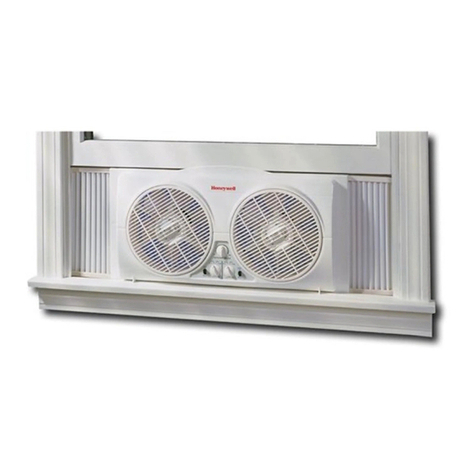
Honeywell
Honeywell TWINDOW HW-628 owner's manual
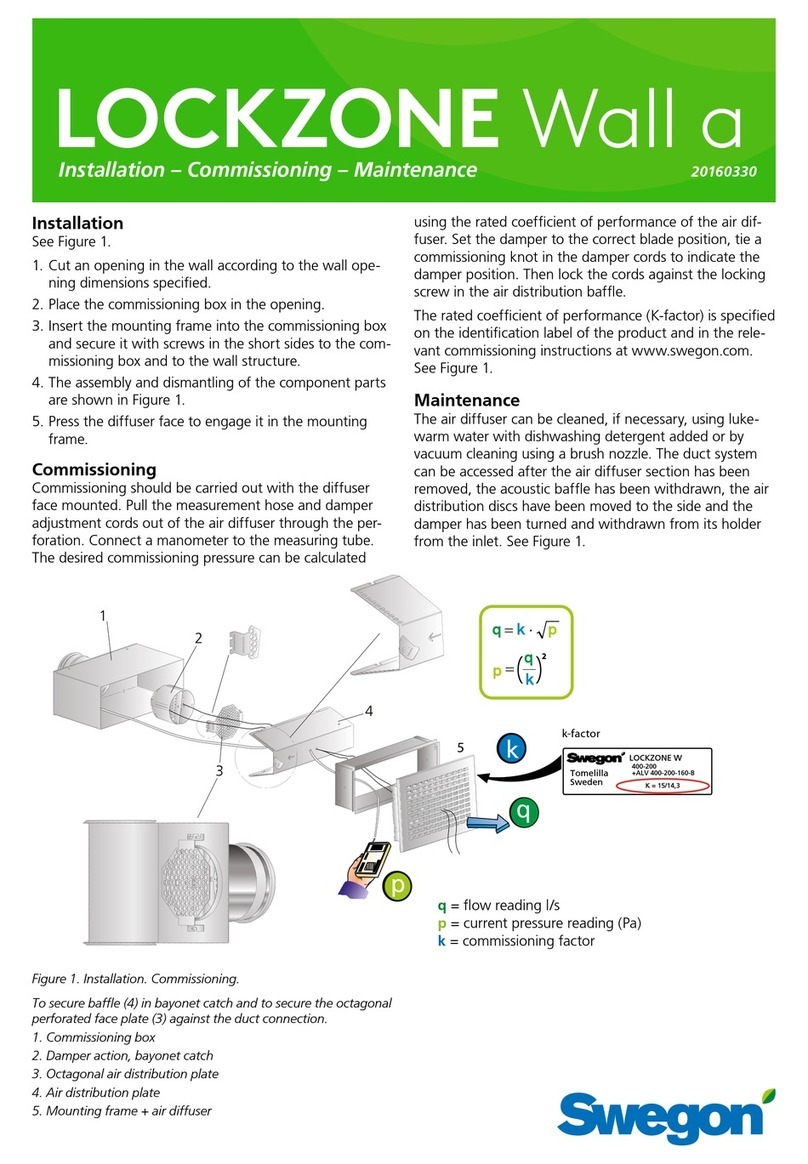
Swegon
Swegon LOCKZONE Wall a quick start guide
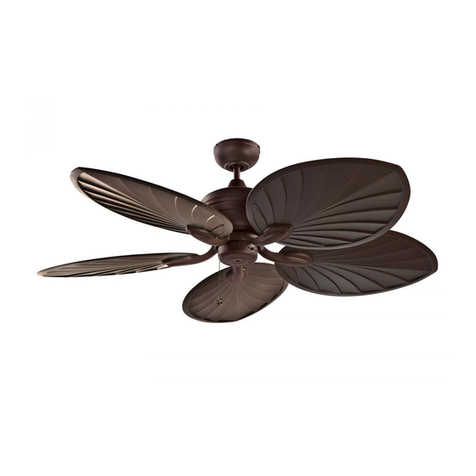
Kendal Lighting
Kendal Lighting AC11152P-ORB/WN installation instructions

Kooper
Kooper 2194486 User instructions

